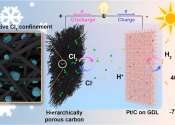Chemists develop polymer cathodes for ultrafast batteries
In the face of the surging demand for lithium-ion batteries and limited lithium reserves, scientists are searching for alternatives to the lithium technology. Russian researchers from Skoltech, D. Mendeleev University, and ...
Jan 18, 2021
0
54









